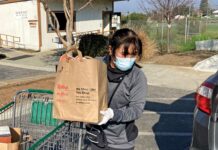Do you have a nature nerd on your Christmas shopping list?
Nature nerd? That’s not very nice. But as with any potentially
disparaging term, I can get away with using it as long as I am
one.
Do you have a nature nerd on your Christmas shopping list? Nature nerd? That’s not very nice. But as with any potentially disparaging term, I can get away with using it as long as I am one.
What do I mean by “nature nerd?” Many people enjoy walking in the outdoors and looking at the wildflowers, the trees and the birds. Nature nerds want to know more. It begins as any new relationship does, with an introduction – a proper name. “That’s an oak” or “That’s a pine tree” or “That’s a blue jay” simply won’t do. It’s either wrong or incomplete. We want to know that it is a black oak or a Jeffrey pine or a scrub jay.
For a nature nerd, such an introduction may grow into a real friendship, and we start asking more questions. Golden-crowned sparrow, where do you go all summer? Woodland shooting star, how many petals do you have? How many stamens? What family are you in? Who else is in your family? Jeffrey pines, where do you grow and why? Who eats your pine nuts, man and/or animal?
Over the years, I have collected a modest library of books that have helped me meet and learn about a few of our wild and native companions. When I was struggling to learn more about my natural history interests, I would have appreciated guidance in choosing “good” books. If you have a nature nerd on your Christmas list, these favorites of mine would be great gifts.
When it comes to birds, you can’t tell the players without a program. There are three excellent field guides, any one of which would be a great source for budding birders. I have always preferred “Western Birds,” a Peterson Field Guide, by Roger Tory Peterson for two reasons. It only features birds west of the 100th meridian, which eases the searching process, and the paintings have what I call “idiot arrows” that point out the distinctive features of various birds, some of which look very similar to other species. The National Geographic Society’s “Field Guide to the Birds of North America” has long been the standard of serious birders, but it covers all of North America. “Sibley Field Guide to Birds of Western North America” is a portable regional version of David Sibley’s more comprehensive “Sibley Guide to Birds.” It is considered to be the new standard in bird guides and is easy to use.
For those interested in raptors and want to learn how to identify these magnificent birds as they soar overhead, “Hawks In Flight” by Pete Dunne, et al is informative and a great read. The colorful plumage of high-flying raptors is not visible to us way down below. This book teaches you to recognize hawks by other visual clues like shape, shades of color and behavior.
To enjoy wildflowers on the simplest level, another Peterson Guide, “A Field Guide to Pacific States Wildflowers,” can’t be beat. No handy-sized regional guide can be comprehensive, but this book contains a lot of our local flowers for those who want to hunt by color and number of petals. As a person’s interest in flowers grows, using a key is the next step. Helen Sharsmith’s “Spring Wildflowers of the San Francisco Bay Region” is a good introduction. By looking at the flowers morphology and answering a series of either/or pairs of questions, you work your way to ultimate identification. For someone who wants to learn about plant families, which is the basis for a sophisticated understanding of wildflowers, “Botany In A Day” by Thomas J. Elpel is a great resource.
I love trees and the diversity of trees in California is unsurpassed. “Oaks of California,” by Bruce M. Pavlik, et al, tells all and shows all about California’s oaks in a beautiful format. “Conifers of California,” by Robert Lanner does the same for California’s cone-bearing trees. Donald Culross Peattie’s classic, “A Natural History of Western Trees,” covers all the trees of the West.
For your nature nerd, any of these books will be a great gift and will soon become a beloved and tattered old friend.











